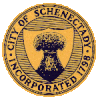Schenectady, NY
| Schenectady, New York | ||
|---|---|---|
| City | ||

Nott Memorial Hall, Union College
|
||
|
||
| Motto: "The city that lights and hauls the world." | ||
 Location in Schenectady County and the state of New York. |
||
| Coordinates: 42°48′51″N 73°56′14″W / 42.81417°N 73.93722°WCoordinates: 42°48′51″N 73°56′14″W / 42.81417°N 73.93722°W | ||
| Country | United States | |
| State | New York | |
| County | Schenectady | |
| Region | Capital District | |
| Settled | 1661 | |
| Incorporated | 1798 | |
| Government | ||
| • Mayor | Gary McCarthy (D) | |
| Area | ||
| • Land | 10.9 sq mi (28 km2) | |
| • Water | 0.1 sq mi (0.3 km2) | |
| Population (2010) | ||
| • City | 66,135 | |
| • Metro | 1,170,483 | |
| Time zone | Eastern (EST) (UTC-5) | |
| • Summer (DST) | EDT (UTC-4) | |
| ZIP code | 12301–12309, 12325, 12345 | |
| Area code(s) | 518 | |
| FIPS code | 36-65508 | |
| GNIS feature ID | 0964570 | |
| Website | www |
|
Schenectady /skᵻˈnɛktədi/ (skə-NEK-tə-dee) is a city in Schenectady County, New York, United States, of which it is the county seat. As of the 2010 census, the city had a population of 66,135. The name "Schenectady" is derived from a Mohawk word skahnéhtati meaning "beyond the pines". The city was founded on the south side of the Mohawk River by Dutch colonists in the 17th century, many from the Albany area. They were prohibited from the fur trade by the Albany monopoly, which kept its control after the English takeover in 1664. Residents of the new village developed farms on strip plots along the river.
Connected to the west via the Mohawk River and Erie Canal, the city developed rapidly in the 19th century as part of the Mohawk Valley trade, manufacturing and transportation corridor. By 1824 more people worked in manufacturing than agriculture or trade, and the city had a cotton mill, processing cotton from the Deep South. Numerous mills in New York had such ties with the South. Through the 19th century, nationally influential companies and industries developed in Schenectady, including General Electric and American Locomotive Company (ALCO), which were powers into the mid-20th century. The city was part of emerging technologies, with GE collaborating in the production of nuclear-powered submarines and, in the 21st century, working on other forms of renewable energy.
...
Wikipedia

